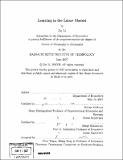| dc.contributor.advisor | Robert Gibbons and Bengt Holmstrom. | en_US |
| dc.contributor.author | Li, Jin, Ph. D. Massachusetts Institute of Technology | en_US |
| dc.contributor.other | Massachusetts Institute of Technology. Dept. of Economics. | en_US |
| dc.date.accessioned | 2007-12-07T16:11:58Z | |
| dc.date.available | 2007-12-07T16:11:58Z | |
| dc.date.copyright | 2007 | en_US |
| dc.date.issued | 2007 | en_US |
| dc.identifier.uri | http://hdl.handle.net/1721.1/39717 | |
| dc.description | Thesis (Ph. D.)--Massachusetts Institute of Technology, Dept. of Economics, 2007. | en_US |
| dc.description | Includes bibliographical references. | en_US |
| dc.description.abstract | This thesis is a collection of three independent essays that study the implication of learning on labor mobility, labor supply, wage distribution, wage dynamics, and allocations of workers under different assumptions about the nature of employer learning. The first essay develops a model of job mobility and wage dispersion under the assumption that the current employers have superior information about their workers over outside firms. The superior information of the workers does not lead to market collapse. Instead, there is a unique mixed strategy equilibrium which leads to a positive amount of turnover and a nondegenerate wage distribution. This model implies that a skill-biased technology change that also favors general skill can lead to increase both in job mobility and wage dispersion. This sheds light, on the joint evolution of job mobility and wage dispersion in the U.S. in the past 30 years. The second essay studies the wage distribution and wage dynamics under matching and symmetric Pareto learning. I develop a model that contains pure learning and pure matching as limiting cases. In addition, the model generates effects that arise from the interaction of learning and matching. In particular, the model generates an earning profile typically obtained in a Mincerian regression. | en_US |
| dc.description.abstract | (cont.) Moreover, the model predicts that the wage residuals are more likely to be serially correlated in younger workers in industries with increasingly convex wage schedules. This helps reconcile the conflicting findings that positive correlations are found in small, homogenous samples but not large, heterogeneous samples. The third essay, jointly with Peter Schnabl, develops a, model that examines the optimal solution to the problem of assigning workers into jobs under adverse selections. Workers differ by their disutility of effort. Jobs differ by their productivity and ease of effort-monitoring. Firms would like to assign hard workers to higher level jobs because efforts on these jobs are harder to monitor. To prevent the lazy workers from mimicking the hard workers, we study the use of two instruments firms may use: requiring long hours and distorting job assignments. The model has an essentially unique separating equilibrium. In equilibrium, workers are required to exert inefficiently high levels of effort and firms commit to promote only a fraction of qualified workers. | en_US |
| dc.description.statementofresponsibility | by Jin Li. | en_US |
| dc.format.extent | 180 p. | en_US |
| dc.language.iso | eng | en_US |
| dc.publisher | Massachusetts Institute of Technology | en_US |
| dc.rights | M.I.T. theses are protected by copyright. They may be viewed from this source for any purpose, but reproduction or distribution in any format is prohibited without written permission. See provided URL for inquiries about permission. | en_US |
| dc.rights.uri | http://dspace.mit.edu/handle/1721.1/7582 | |
| dc.subject | Economics. | en_US |
| dc.title | Learning in the labor market | en_US |
| dc.type | Thesis | en_US |
| dc.description.degree | Ph.D. | en_US |
| dc.contributor.department | Massachusetts Institute of Technology. Department of Economics | |
| dc.identifier.oclc | 180190386 | en_US |

